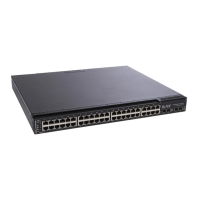© Copyright IBM Corp. 2011 Chapter 15. Basic IP Routing 189
Dynamic Host Configuration Protocol
Dynamic Host Configuration Protocol (DHCP) is a transport protocol that provides a
framework for automatically assigning IP addresses and configuration information to
other IP hosts or clients in a large TCP/IP network. Without DHCP, the IP address
must be entered manually for each network device. DHCP allows a network
administrator to distribute IP addresses from a central point and automatically send
a new IP address when a device is connected to a different place in the network.
The switch accepts gateway configuration parameters if they have not been
configured manually. The switch ignores DHCP gateway parameters if the gateway
is configured.
DHCP is an extension of another network IP management protocol, Bootstrap
Protocol (BOOTP), with an additional capability of being able to allocate reusable
network addresses and configuration parameters for client operation.
Built on the client/server model, DHCP allows hosts or clients on an IP network to
obtain their configurations from a DHCP server, thereby reducing network
administration. The most significant configuration the client receives from the server
is its required IP address; (other optional parameters include the “generic” file name
to be booted, the address of the default gateway, and so forth).
To enable DHCP on a switch interface, use the following command:
DHCP Relay Agent
DHCP is described in RFC 2131, and the DHCP relay agent supported on the
G8000 is described in RFC 1542. DHCP uses UDP as its transport protocol. The
client sends messages to the server on port 67 and the server sends messages to
the client on port 68.
DHCP defines the methods through which clients can be assigned an IP address for
a finite lease period and allowing reassignment of the IP address to another client
later. Additionally, DHCP provides the mechanism for a client to gather other IP
configuration parameters it needs to operate in the TCP/IP network.
In the DHCP environment, the G8000 acts as a relay agent. The DHCP relay feature
enables the switch to forward a client request for an IP address to two BOOTP
servers with IP addresses that have been configured on the switch.
When a switch receives a UDP broadcast on port 67 from a DHCP client requesting
an IP address, the switch acts as a proxy for the client, replacing the client source IP
(SIP) and destination IP (DIP) addresses. The request is then forwarded as a UDP
Unicast MAC layer message to two BOOTP servers whose IP addresses are
configured on the switch. The servers respond as a UDP Unicast message back to
the switch, with the default gateway and IP address for the client. The destination IP
address in the server response represents the interface address on the switch that
received the client request. This interface address tells the switch on which VLAN to
send the server response to the client.
RS G8000(config)# system dhcp

